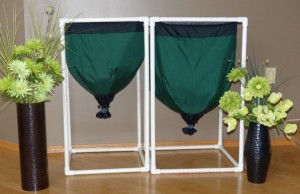6 Fundamental Requirements That Worms Need:
- Moisture: Damp like a wrung out sponge, but not dripping wet. Worms breath through their skin so it is critical that they are kept moist.
- Oxygen/Air Flow: Air flow is critical to a no smell environment. Worms breath through their skin so they need oxygen to breath as well.
- Temperature: Optimum temperature is between 60-80F (16-27C). Any colder or hotter and the worms metabolism slows down. They live in the top 6-12" of soil so they will freeze in the winter and dry out in the summer.
- Darkness: Worms skin is very sensative to light and they like it dark.
- Habitant/Bedding: like a ratio of 20 parts carbon (newspaper,cardboard,etc) to 1 part nitrogen (food scraps).
- Food: See Feeding/Caring for worms page.
- Peace and Quiet: Worms do not like to be disturbed and are very sensitive to vibration noise. When they sense motion they get scared and head downward to try and escape.
There are many different worm bins system that can be purchased or made. Each has pros and cons.
1. Plastic Bin System
PRO:
- Cost - $6.00 - $9.00.
- Assembly: easy but do need power tools.
CON:
- Plastic - very poor air flow.
- Moisture - usually too moist because plastic can't breath properly and poor air flow.
- Oxygen/Air Flow - poor no matter how many holes you drill or vents are one inserted.
- Food - need to feed smaller amounts again due to lack of airflow and lack of room.
- Labor intensive - a lot to work to maintain balance and messy.
- Smells - attracts fruit flies.
- Leakage - the leachate (extra moisture) leaks out the bottom holes in the bin and is messy to dump. If it is left to sit for awhile if goes anerobic and smells.
My experience: Many people start with this system, as I did, because it is inexpensive. Most end up discouraged and get rid of their worms because it is quite time consuming, messy, can be quite smelly at times and it is difficult to separate the worms from their castings easily.
2. Stacking Tray System
PRO:
- Harvesting - easier than plastic bin system.
- Oxygen/Air Flow - designed to allow more air flow than in a plastic bin system.
- Moisture - easier to maintain than plastic bin system.
- Moisture Collection Tray - makes up the base of the tray system.
CON:
- Habitat/Bedding - trays aren't deep enough to allow adequate burying of food.
- Plastic Trays - made of plastic so again poor air flow.
- Collection tray - always has castings and worms in it. Meant to collect leachate in the bottom and can smell and drown the worms that have dropped into the bottom if left to sit for any period of time.
- Fruit flies - easy access to food scraps as they aren't buried deep enough under bedding
- Cost - $120.00 - $160.00 CDN
My Experience: Easier and less time consuming to harvest worms from castings however quite messy, frequently lifting and manuvering heavy trays, soil compacts down too tightly, and smaller size worms due to confined area to move about. Limited to feed small amounts of food scraps at a time so there is room to bury under some bedding. Liked this system better than the plastic bin system, however it was alot messier in that castings and shredded paper were always falling on the floor.
3. Flow Through system
PROS:
- Oxygen/Air Flow - optimal air flow; totally breathable right to the inner core as it is made of breathable, durable cordura fabric.
- Moisture - extra moisture can drip out the bottom if needed. Easy to water through the zippered mesh covering. Easy to see if you are over watering or underwatering.
- Food - can feed up to 10 times more food than the previous too systems.
- Fruit Flies - almost non-issue because of mesh zipper screening.
- Smells - none.
- Harvesting - quick and easy with very few worms in the harvest. Worms aren't disturbed when harvesting.
CONS:
- Moisture - because it is so breathable you have to add water more often.
- Cost - $100.00 - $150.00
My Experience: Can you tell why I love this type of system! I began manufacturing this system because I believe it is the easiest, most convenient, least labor intensive system on the market. The price is within range of all the other systems. The worms grow, eat and reproduce like crazy and all the customers LOVE it!







